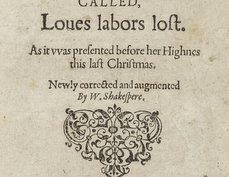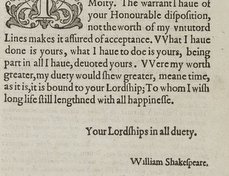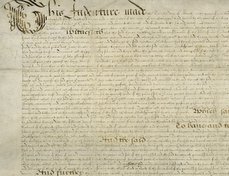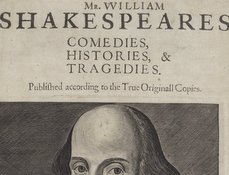Partners | Explore | Credits & acknowledgements
A multi-institutional resource convened by the Folger Shakespeare Library to commemorate the 400th anniversary of Shakespeare’s death
Shakespeare Documented is the largest and most authoritative collection of primary-source materials documenting the life of William Shakespeare (1564-1616), bringing together all known manuscript and print references to Shakespeare, his works, and additional references to his family, in his lifetime and shortly thereafter. Nearly 500 references, found in roughly 400 print and manuscript documents, provide a rich portrait of Shakespeare as a professional playwright, actor, poet, business man, and family man who lived in both London and Stratford-upon-Avon. These documents trace Shakespeare’s path to becoming a household name, from the earliest reference to his father in Stratford-upon-Avon, a bustling market town in Warwickshire, in 1552, to the publication of his collected plays, now known as the “First Folio,” in 1623, to the earliest gossipy references to Shakespeare in the following decades.
On this site you will find images, descriptions, and transcriptions of:
- 107 manuscripts that refer to William Shakespeare by name in his lifetime (spelled in many different ways, which was typical of the period), including four manuscripts signed by him, and one letter addressed to him
- 95 printed books and manuscripts from Shakespeare's lifetime that mention or quote his plays or poems, or that refer to him directly or indirectly as a writer
- 34 Stationers’ Register entries for Shakespeare’s plays and poems, up to and including the First Folio (1623), five of which name him as author
- 84 printed editions of Shakespeare’s plays and poems, up to and including the First Folio (1623), 62 of which include his name on the title-page or dedicatory leaf
- More than 100 documents that refer to other members of Shakespeare's family, including references to Shakespeare's coat of arms
This is a remarkable legacy for someone of his socio-economic status and profession. Like many other professional writers, Shakespeare did not come from an aristocratic household in which family papers were saved and passed from one generation to the next as a matter of course. Shakespeare's last descendant, his grand-daughter Elizabeth Barnard, died in 1670, and New Place, his house, no longer remained in the family. Thus, it is to be expected that no personal papers survive. However, in his own lifetime, Londoners took note of Shakespeare: they attended his plays, purchased and read his plays and poems, commented on his acting and writing, and compared him to other writers, living and dead. At the same time, bureaucrats took note of him in the financial and legal paperwork of Renaissance England. The range of surviving references, found in administrative documents, commercially-published works, and in the personal papers of private individuals, provide a detailed account of Shakespeare's life, albeit one with expected gaps and silences.
The Shakespeare Documented logo
The main image on our site reproduces John Shakespeare's coat of arms, inherited by William Shakespeare upon his father's death in 1601. It is one of two surviving contemporary examples of the coat of arms in color (the other representations being either in trick or in blazon). The image is one of a group of coats of arms and descriptions that form the body of Garter and Clarencieux Kings of Arms' response to York Herald in 1602. The College of Arms has graciously permitted us to incorporate this document into the design of our site: the icon is a stylized motif of the coat of arms, and title bars include a faded detail from the related text in the manuscript. We invite you to learn more about this document under the entry for Shakespeare's arms in color.
Terms and conditions
The Folger Shakespeare Library owns the Shakespeare Documented domain name and site. Each contributing institution retains ownership of their contributed material. Users must consult each institution's terms of use before using the materials, which are posted with every contributed item and on each institution's Partner page.
Images
For the use of images, visitors must consult and follow the contributing institution's specific terms of use granted for their material. These terms are posted in the "Institution Rights and Document Citation" field below each image, and on each institution's Partner page.
Site text
Unless otherwise noted, text used within the site (such as document descriptions, transcriptions, and essays) may be used under the terms of the Folger Shakespeare Library’s CC BY-SA 4.0 license, requiring proper attribution to the author and Shakespeare Documented.
Supported in part by The Gladys Krieble Delmas Foundation.









